College during COVID-19: Psychology professors adapt to online learning using a lightboard
“College during COVID-19” is a video series in which CSUN students and faculty share their fall semester virtual learning or teaching experiences during the coronavirus pandemic.
October 7, 2020
The COVID-19 pandemic is not the first time Andrew Ainsworth, a psychology professor, has had to adapt to a challenge while at CSUN.
“I started as an undergrad here in 1994, the semester after the earthquake. At first, I knew nothing but trailers. I don’t think I had a class in a building until I was a junior,’’ he said. Ainsworth also completed his master’s degree at CSUN and returned to campus after his doctorate to teach in the psychology department.
Nevertheless, Ainsworth acknowledged that the pandemic has presented a unique challenge for professors. The buildings are there but the students are not and it is not easy to teach or learn via a webcam feed. Ainsworth noted that it is particularly challenging for STEM disciplines, which require intense focus and attention to detail.
“The classes I teach are usually the ones the students try to avoid taking or put off until the end,” he said with a chuckle. Those dreaded classes: upper-level statistics.
The professor realized he needed a better tool than Zoom to engage the students with complicated material.
The Discovery of the Lightboard
Coincidentally, he had been experimenting with an open-source hardware called Lightboard, also known as “learning glass,’’ which is an illuminated glass board created to record video lectures.
“It was kismet,’’ the psychology professor enthusiastically pointed out more than once. “The timing could not have been more perfect.’’
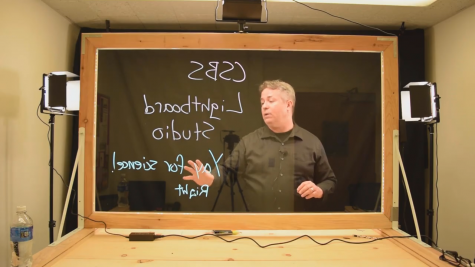
The Lightboard allows for the professor to be in the frame interacting with the material, such as slides, videos and equations, instead of being present only as a disembodied voice over a PowerPoint presentation.
From the outset, the project had the support of Yan Dominic Searcy, the dean of the College of Social and Behavioral Sciences, who provided Ainsworth and Wilson with a room and funding.
The Lightboard at CSUN was built by Ainsworth and Essence Lynn Wilson, a then-graduate student in the psychology department, in Sierra Hall in February. It was created for Wilson’s study of whether it was an effective teaching tool compared to the famous online Khan Academy.
Wilson’s research showed that Lightboard-based tutorials in online learning promote increased retention and increased enjoyment by students, especially for challenging topics like statistics.
Ditching the regular Zoom format
Ainsworth decided to try teaching a class using the Lightboard and the response from students was so positive that he has used it ever since. With the Lightboard, Ainsworth is able to fill out statistics tables and resolve problems with students, which he said has been invaluable for him as a professor.
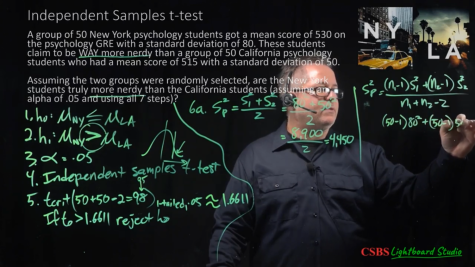
The CSBS Lightboard studio caught the attention of assistant psychology professor Thomas Chan, who has a background in tech start-ups. “Everybody [in the faculty] was scrambling, especially in mid-March. What’s going on?’’ he said. Chan also said that is why he gravitated toward Ainsworth.
Ainsworth said early in the pandemic faculty were worried about converting course materials online instead of focusing on maintaining quality and student engagement.
Chan started teaching his developmental psychology classes at the Lightboard studio as well, and helped Ainsworth expand the studio and conquer the challenges of pioneering this teaching modality on campus.
“You got to zig when everybody zags. When everybody else is stuck in the mud, we innovate,’’ Chan said.
One of those challenges left Ainsworth with a drill bit in his foot; he proudly displayed the x-ray on the Lightboard as Chan scribbled the word “dedication’’ on it. “I actually bled for this project,’’ Ainsworth said.
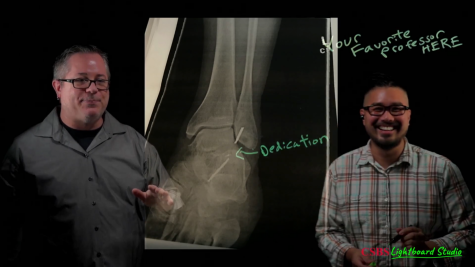
Chan’s enthusiasm can be seen in his highly interactive classes, which include funny trailers for midterms and “Big Lebowski’’ analogies. He signs the Lightboard with, “Your favorite professor’’ in every class and is constantly doodling humorous notes and drawings on the Lightboard.
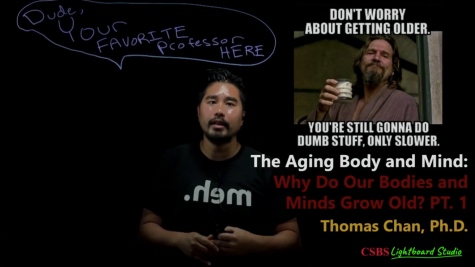
The Lightboard studio now has a multi-camera setup and stereo microphones, which will allow for students wearing headphones to feel like they are in the room with the professor as the sound of the professor’s voice will move from one ear to the other when the lecturer moves about the studio.
All lectures are recorded live and are available on Chan and Ainsworth’s Youtube channels afterwards.
Future-proofing Higher-Education
“You can tell we’re excited about all this because we want our colleagues to get involved in this,’’ Chan said.
Chan has lofty goals when it comes to how he sees the Lightboard’s potential for his college and CSUN.
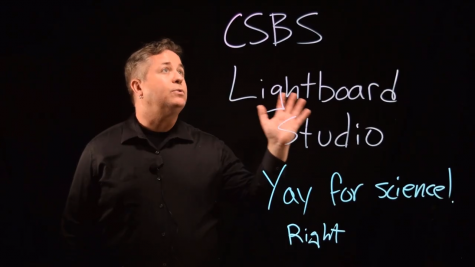
Ainsworth backed his colleague: “We have always had a really strong department and teaching is one of our strengths. We’ve been in [top school] rankings multiple times.’
The Lightboard studio in Sierra Hall or the know-how to create one is not limited to the CSBS. Both Chan and Ainsworth are open to show other faculty the ropes and also get them started in their own Lightboard studios.
A complete commercial Lightboard setup usually starts around $10,000 but Ainsworth built the CSBS one for a fraction of that. Ainsworth mentioned that “the whole setup was not expensive at all. The most expensive part was the converters. The thick glass pane itself was $120.’’
The main barrier, according to Ainsworth, is having faculty who are willing to ditch their homely comforts and possibly brave the coronavirus to travel to campus and record the classes.
CSUN faculty who are interested in utilizing the Lightboard studio can contact Ainsworth at andrew.ainsworth@csun.edu or Chan at thomas.chan@csun.edu.
